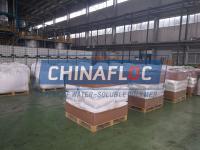Cationic polyacrylamide can be replaced by the CHINAFLOC series
two cationic polyacrylamide with very low and very high charge ,mainly used for water treatment and sludge dewatering
Cationic polyacrylamide (CPAM) is a water-soluble linear polymer flocculant, which is formed by copolymerization of cationic monomer and acrylamide monomer. Mainly used in sewage flocculation sedimentation and sludge dewatering and other purposes.
I. Technical Indicators:
Product appearance: white granules
Solid content: ≥88%
Molecular weight (ten thousand) : 200-1000
Ionic degree: 5-80%
Dissolution time (min) : 60-90
Ii. Product features:
1, the use of economic, in a very low dosage, you can achieve good use effect;
2, can significantly improve the sludge production efficiency or reduce the mud cake moisture content;
3, in the production process of solid-liquid separation, can improve the sedimentation rate of suspended solids;
4, in a wide range of pH (2-9) effective work, can deal with sewage and sludge under weak acidic conditions.
Iii. Types and models:
Cationic polyacrylamide is generally divided into: strong cation, medium cation, weak cation
Four, application areas:
(1) Can be used in but not limited to the following fields,
(2) It can be used for sludge dewatering of belt, centrifugal and spiral dehydrator, which can significantly improve the production efficiency, the solid content of mud cake and reduce the solid content of filtered water;
(3) Can be used for air floatation, can improve the clarity of water, and improve the production efficiency of air floatation machine;
(4) Used for filtration, improve the quality of water filtration and improve the production efficiency of filter machine;
(5) concentration, which can improve the concentration efficiency and speed up the sedimentation rate;
(6) The clarification of sewage can effectively reduce the SS value and turbidity of the treated water and improve the effluent quality;
The above are just some basic applications of the product. The product can also be used in other solid-liquid separation processes.

